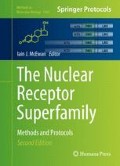Abstract
Chromatin immunoprecipitation (ChIP) provides a means of enriching DNA associated with transcription factors, histone modifications, and indeed any other proteins for which suitably characterized antibodies are available. Over the years, sequence detection has progressed from quantitative real-time PCR and Southern blotting to microarrays (ChIP-chip) and now high-throughput sequencing (ChIP-seq). This progression has vastly increased the sequence coverage and data volumes generated. This in turn has enabled informaticians to predict the identity of multi-protein complexes on DNA based on the overrepresentation of sequence motifs in DNA enriched by ChIP with a single antibody against a single protein. In the course of the development of high-throughput sequencing, little has changed in the ChIP methodology until recently. In the last three years, a number of modifications have been made to the ChIP protocol with the goal of enhancing the sensitivity of the method and further reducing the levels of nonspecific background sequences in ChIPped samples. In this chapter, we provide a brief commentary on these methodological changes and describe a detailed ChIP-exo method able to generate narrower peaks and greater peak coverage from ChIPped material.
Access this chapter
Tax calculation will be finalised at checkout
Purchases are for personal use only
References
Solomon MJ, Larsen PL, Varshavsky A (1988) Mapping protein–DNA interactions in vivo with formaldehyde: evidence that histone H4 is retained on a highly transcribed gene. Cell 53(6):937–947
Ren B, Robert F, Wyrick JJ, Aparicio O, Jennings EG, Simon I, Zeitlinger J, Schreiber J, Hannett N, Kanin E, Volkert TL, Wilson CJ, Bell SP, Young RA (2000) Genome-wide location and function of DNA binding proteins. Science 290(5500):2306–2309. doi:10.1126/science.290.5500.2306
Barski A, Cuddapah S, Cui K, Roh T-Y, Schones DE, Wang Z, Wei G, Chepelev I, Zhao K (2007) High-resolution profiling of histone methylations in the human genome. Cell 129(4):823–837. doi:10.1016/j.cell.2007.05.009
Robertson G, Hirst M, Bainbridge M, Bilenky M, Zhao Y, Zeng T, Euskirchen G, Bernier B, Varhol R, Delaney A, Thiessen N, Griffith OL, He A, Marra M, Snyder M, Jones S (2007) Genome-wide profiles of STAT1 DNA association using chromatin immunoprecipitation and massively parallel sequencing. Nat Methods 4(8):651–657. doi:10.1038/nmeth1068
Landt SG, Marinov GK, Kundaje A, Kheradpour P, Pauli F, Batzoglou S, Bernstein BE, Bickel P, Brown JB, Cayting P, Chen Y, DeSalvo G, Epstein C, Fisher-Aylor KI, Euskirchen G, Gerstein M, Gertz J, Hartemink AJ, Hoffman MM, Iyer VR, Jung YL, Karmakar S, Kellis M, Kharchenko PV, Li Q, Liu T, Liu XS, Ma L, Milosavljevic A, Myers RM, Park PJ, Pazin MJ, Perry MD, Raha D, Reddy TE, Rozowsky J, Shoresh N, Sidow A, Slattery M, Stamatoyannopoulos JA, Tolstorukov MY, White KP, Xi S, Farnham PJ, Lieb JD, Wold BJ, Snyder M (2012) ChIP-seq guidelines and practices of the ENCODE and modENCODE consortia. Genome Res 22(9):1813–1831. doi:10.1101/gr.136184.111
Shankaranarayanan P, Mendoza-Parra M-A, Walia M, Wang L, Li N, Trindade LM, Gronemeyer H (2011) Single-tube linear DNA amplification (LinDA) for robust ChIP-seq. Nat Methods 8(7):565–567. doi:10.1038/nmeth.1626
Adli M, Bernstein BE (2011) Whole-genome chromatin profiling from limited numbers of cells using nano-ChIP-seq. Nat Protoc 6(10):1656–1668. doi:10.1038/nprot.2011.402
Goren A, Ozsolak F, Shoresh N, Ku M, Adli M, Hart C, Gymrek M, Zuk O, Regev A, Milos PM, Bernstein BE (2010) Chromatin profiling by directly sequencing small quantities of immunoprecipitated DNA. Nat Methods 7(1):47–49. doi:10.1038/nmeth.1404
Fanelli M, Amatori S, Barozzi I, Minucci S (2011) Chromatin immunoprecipitation and high-throughput sequencing from paraffin-embedded pathology tissue. Nat Protoc 6(12):1905–1919. doi:10.1038/nprot.2011.406
Zwart W, Koornstra R, Wesseling J, Rutgers E, Linn S, Carroll JS (2013) A carrier-assisted ChIP-seq method for estrogen receptor-chromatin interactions from breast cancer core needle biopsy samples. BMC Genomics 14:232. doi:10.1186/1471-2164-14-232
Rhee HS, Pugh BF (2011) Comprehensive genome-wide protein–DNA interactions detected at single-nucleotide resolution. Cell 147(6):1408–1419. doi:10.1016/j.cell.2011.11.013
Serandour AA, Brown GD, Cohen JD, Carroll JS (2013) Development of an illumina-based ChIP-exonuclease method provides insight into FoxA1-DNA binding properties. Genome Biol 14(12):R147. doi:10.1186/gb-2013-14-12-r147
Massie CE, Lynch A, Ramos-Montoya A, Boren J, Stark R, Fazli L, Warren A, Scott H, Madhu B, Sharma N, Bon H, Zecchini V, Smith D-M, Denicola GM, Mathews N, Osborne M, Hadfield J, Macarthur S, Adryan B, Lyons SK, Brindle KM, Griffiths J, Gleave ME, Rennie PS, Neal DE, Mills IG (2011) The androgen receptor fuels prostate cancer by regulating central metabolism and biosynthesis. EMBO J 30(13):2719–2733. doi:10.1038/emboj.2011.158
Sharma NL, Massie CE, Ramos-Montoya A, Zecchini V, Scott HE, Lamb AD, MacArthur S, Stark R, Warren AY, Mills IG, Neal DE (2013) The androgen receptor induces a distinct transcriptional program in castration-resistant prostate cancer in man. Cancer Cell 23(1):35–47. doi:10.1016/j.ccr.2012.11.010
Yu J, Yu J, Mani R-S, Cao Q, Brenner CJ, Cao X, Wang X, Wu L, Li J, Hu M, Gong Y, Cheng H, Laxman B, Vellaichamy A, Shankar S, Li Y, Dhanasekaran SM, Morey R, Barrette T, Lonigro RJ, Tomlins SA, Varambally S, Qin ZS, Chinnaiyan AM (2010) An integrated network of androgen receptor, polycomb, and TMPRSS2-ERG gene fusions in prostate cancer progression. Cancer Cell 17(5):443–454. doi:10.1016/j.ccr.2010.03.018
Sahu B, Laakso M, Ovaska K, Mirtti T, Lundin J, Rannikko A, Sankila A, Turunen J-P, Lundin M, Konsti J, Vesterinen T, Nordling S, Kallioniemi O, Hautaniemi S, Jänne OA (2011) Dual role of FoxA1 in androgen receptor binding to chromatin, androgen signalling and prostate cancer. EMBO J 30(19):3962–3976. doi:10.1038/emboj.2011.328
Zhang Y, Liu T, Meyer CA, Eeckhoute J, Johnson DS, Bernstein BE, Nusbaum C, Myers RM, Brown M, Li W, Liu XS (2008) Model-based analysis of ChIP-Seq (MACS). Genome Biol 9(9):R137. doi:10.1186/gb-2008-9-9-r137
Author information
Authors and Affiliations
Corresponding authors
Editor information
Editors and Affiliations
Rights and permissions
Copyright information
© 2016 Springer Science+Business Media New York
About this protocol
Cite this protocol
Barfeld, S.J., Mills, I.G. (2016). Mapping Protein–DNA Interactions Using ChIP-exo and Illumina-Based Sequencing. In: McEwan, PhD, I. (eds) The Nuclear Receptor Superfamily. Methods in Molecular Biology, vol 1443. Humana Press, New York, NY. https://doi.org/10.1007/978-1-4939-3724-0_8
Download citation
DOI: https://doi.org/10.1007/978-1-4939-3724-0_8
Published:
Publisher Name: Humana Press, New York, NY
Print ISBN: 978-1-4939-3722-6
Online ISBN: 978-1-4939-3724-0
eBook Packages: Springer Protocols

